Johnnie Johnson's MK392
The Spitfire IXe was a development of the standard Spitfire IX that inverted the position of the 20mm cannons and replaced the outboard .30 caliber machine guns with .50 caliber weapons in the wing position formerly occupied by the cannons.
Interestingly enough, while the IXe wing entered production in the Spring of 1944, many Spitfires thought to be examples of this sub-type are actually earlier Spitfires, with a “field modification” to change the gun position, without the inner .50 caliber weapon, which was done due to the fact that with Spitfires being equipped with bomb racks for the fighter-bomber role in the invasion of France, having a 250-lb bomb and a 20mm cannon in the same wing location put too much strain on the wing structure.
Such an airplane was MK392, the Spitfire flown by Wing Commander Johnny Johnson when he returned to combat operations in March 1944 to assume command of a second Canadian Spitfire wing, 144 Wing in 83 Group of the 2nd Tactical Air Force which became 144 RCAF (Fighter) Wing, a fighter/bomber unit comprised of 441, 442 and 443 Squadrons. MK392, the Spitfire Johnson flew with 144 Wing has now been identified as being originally produced as a Spitfire IXc. In June 1944, Johnson had an MU modify the airplane by changing the gun positions, which was not difficult since MK392 used the large teardrop-shaped “universal gun cover.” All the Spitfires in 144 Wing, which did include some early IXe airplanes that were not equipped with the .50 caliber machine guns (which only made their appearance in the fall of 1944 due to production delays of the weapons), removed the outer .30 caliber weapons to save weight since the rifle-caliber weapons were not considered particularly effective either in strafing or air combat.
Following the 144 Normandy Invasion, 144 Wing became the first Allied unit to be based in Europe, and during the intense aerial battles over Normandy that summer, the wing became the top-scoring RCAF fighter wing of the war. W/C Johnson scored his 22nd-34th victories while leading the wing, with his final victory scored on September 27, 1944 over Nijmegen in support of Operation Market Garden.
Johnson himself thought that the achievement of Sailor Malan in scoring 32 victories in 1940-41 was superior to his own. Writing in his autobiography “Wing Leader,” he said: "Malan had fought with great distinction when the odds were against him. He matched his handful of Spitfires against greatly superior numbers of Luftwaffe fighters and bombers. He had been forced to fight a defensive battle over southern England and often at a tactical disadvantage, when the top‑cover Messerschmitts were high in the sun. I had always fought on the offensive, and, after 1941, I had either a squadron, a wing or sometimes two wings behind me.”
Johnson was credited with 34 individual victories over enemy aircraft, as well as seven shared victories, three shared probables, 10 damaged, three shared damaged and one destroyed on the ground. Between 1940-45, he flew 700 operational sorties and engaged enemy aircraft on 57 occasions. His list of victories included 14 Bf-109s and 20 Fw-190s destroyed, making him the most successful RAF ace against the Fw 190, with his total score making him the highest-scoring Western Allied ace against the Luftwaffe.
Eduard has determined to make each of their kits of the various marks of Spitfire IX separate by molding the wings such that there can be no “mix and match” of gun covers and weapons, as is possible with the Hasegawa and ICM Spitfire Ixs.
The IXe has come in both a Profipack kit with the usual photo-etch details and decals for several aircraft, and the less-expensive Weekend Edition that omits the photo-etch and provides only one set of decals, which do not include the extensive stenciling found on the Spitfire. Most modelers of Spitfires have access to aftermarket decal sheets that provide other markings options and also contain the necessary stencils, so this lack is not a problem and the savings on the price allow one to have more than one model in the collection.
I had determined that I was going to do Johnson's MK392 after looking at some photos of how ragged the D-Day stripes were on this plane, which would allow me to experiment with doing “bad” D-Day stripes, which most modelers avoid like the plague since they fear uninformed judges at the International PMS society model contests will “ding” them for not “doing them right.” Since I don't waste my time on contests, this isn't a problem.
Of course, once I got the bit in my teeth to do this, using the decals from “Spitfire: Aces of the Empire,” I did a little reading and discovered that MK392 was not a standard IXe. I suppose I could have found an actual IXe with the markings option I wanted to do, but now I Was Committed. Fortunately, I happened to have the large “universal gun cover” in resin from a Spitfire Vc conversion set. I cut off the narrow-chord gun cover and replaced it with the resin cover, then proceeded to build the kit as I had all the other Eduard Spitfires I have done, with the exception of using the instrument panel decal in place of the non-existent photo-etch and lead foil from a wine bottle to create seat belts in replacement of the non-existent photo-etch.
The “big deal” here was to do “crappy” D-Day stripes as if they had been hurriedly hand-painted. I decided to do MK392 as she would have looked after the move to Normandy, when the upper stripes were removed from the wing and fuselage.
After pre-shading the model with flat black along the panel lines, I then airbrushed a thin coat of Flat White, which allowed the undersurface colors through as though it was worn paint. I then hand-painted the borders of the black stripes, making certain that no two stripes were the same width, per photos of MK392, then airbrushed the black stripes. I then hand painted the outer borders of the stripes with Sea Grey Medium to get the uneven look. Past that, the rest of the painting was creating a standard A-scheme pattern, freehanded with my airbrush (after 30 years of practice airbrushing Spitfires, I have that pattern down right).
I used the stenciling from an Aviaeology decal sheet, and the markings and national insignia from the “Spitfire: Aces of the Empire” sheet. Everything went down without a problem under a coat of Micro-Sol.
I stained the model with exhaust and oil stains, “dinged” areas that would have been worn, then attached the prop and landing gear and the bomb racks, then the open cockpit flap and the canopy in the open position.
If I was doing this model over again, knowing what I know now, I would use the Spitfire IXc “Early Production” kit, which has the universal gun covers. Other than that, I am quite happy with my “crapped up” Spitfire. The Eduard Spitfire IX series are without a doubt the best 1/48 Spitfire Ixs and well worth their price, though the Weekend Edition creates a nice bargain for those “boffins” who have the necessary items for markings and such.
(Before the iModeler Photo Editor chimes in with his review, I am set for a lens replacement in my right - dominant - eye, which has a cataract that leaves me looking through "smeared glass" and getting about 15% less light in that eye than the left. This will happen on November 7. I am told that a month later my eyes will have the clarity they did 30 years ago)
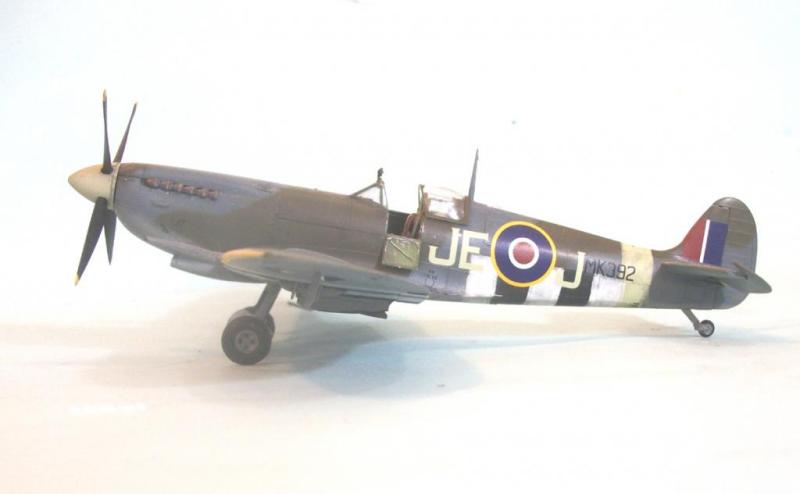
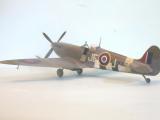
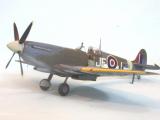
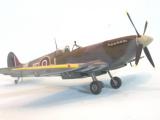
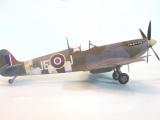
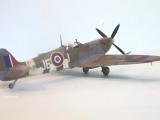
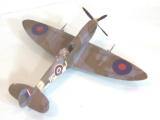
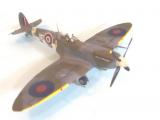
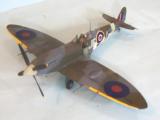
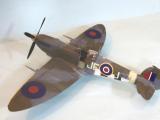
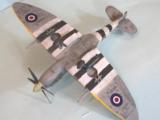
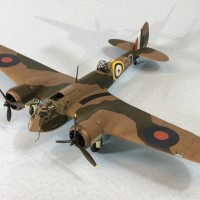
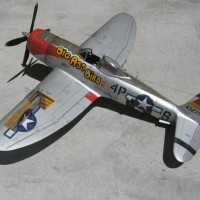
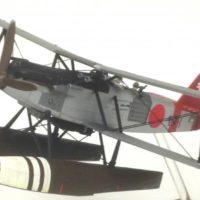
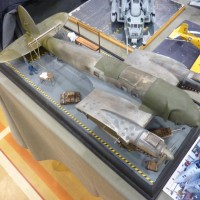
All good luck, TC, with the up-coming eye operation. No doubt with super eye-sight your standards for top quality models will go even higher. Thanks for all the helpful model-building insight at Modeling Madness over the past 16 years, following my return to this great hobby we all really dig the most. .
Bails-In-Minnesota
Nice looking Spit Tom. Great job on the "crappy invasion stripes", ragged edges and blotchy paint is tough to pull off, well intentionally anyway lol.
Sorry to hear about your vision problems, hope the surgery goes well.
"(Before the iModeler Photo Editor chimes in with his review, I am set for a lens replacement in my right – dominant – eye, which has a cataract that leaves me looking through “smeared glass” and getting about 15% less light in that eye than the left. This will happen on November 7. I am told that a month later my eyes will have the clarity they did 30 years ago)"
TC, I always tell folks to stop getting old and no one listens to me. Looks like you get a second chance in the eye department and the majority of modelers will still be on the sidelines ... when it comes to the writing, building and being productive. Looking forward to a younger set of eyes and your keen sense of writing and building models for review.
Tom.
Looks good. Hope all goes well with the surgery. It will. I had the pleasure of meeting Johnson quite a number of years ago. He was a charming man and a great story teller. I gave him a CHP hat but I doubt that it would have done him any good in England.
I met him too, back in 1982 at Virginia Bader's art gallery here in Long Beach. She had her maternal uncle come along - Douglas Bader. They both come from that generation of Englishman that reminds a descendant of American revolutionaries why we gave them The Boot, that condescension that makes you want to punch them. But JEJ completely changed his mind when I pulled out my 1st edition copy of "Wing Leader," the first book I ever bought (at age 10, paid for by sweeping out the bookstore once a week for a month) and telling him that story and asking him to sign it, at which point his attitude changed completely. It turned out we weren't that different, a lesson I kept. Which is why when other people say "JEJ Spitfires - done to death!" I will do a few (next up, EN398 and then his "Bader's Bus Co. - Still Running" Spit Vb).
Tom, I hope everything goes well in the eye department. It is amazing what goes on these days.
California Steve
Oh yeah, everybody tells me it's magic. I'm just deciding what kind of knock-out I want. Not sure I want to be aware that they are Cutting My Eye. Maybe the full knock out, the way I got the Full Internal is the way to go.
As always, Tom your model looks great. I hope the eye surgery goes well.
Another stunner Tom. Thanks for the nice bit of history as usual. Adolf 'Sailor' Malan was a South African pilot flying for the RAF. He was. a sailor, hence the nickname. Malan was instrumental in changing RAF Fighter Command's tacticts and rules in dogfighting. After the war he became a staunch opponent to the apartheid system in South Africa .He founded the Torch Commando as an opposition movement to the apartheid government in SA.
Yeah, Morne, he was a real "patriot" to South Africa at a time it was hard to do - making him not only a "better" fighter ace according to JEJ, but a better patriot as well. I hope guys like him are finally getting the recognition they deserve there.
He is definitely in the SAAF Hall of Fame. Malan and Pattle were the highest scoring South African aces of WW II. Pattle could even been a contender for highest scoring Allied ace. However, he died in combat early in the war.
Actually, I hope Malan is listed as a hero in whatever category has nothing to do with his military service, but rather his moral service to his country.
I fully agree with that Tom. Again I must commend you on your writing. Top class!
Nice work Tom! You did a great job on those stripes, and I like the filthy look of the belly!
Nice work Tom, informative text and great build as per normal.
Good luck with the eye operation.
Nice build there Tom, very convincing weathering and wear. Good luck with the surgery, all the best.
Good luck with the surgery, Tom. My wife will be undergoing the first of hers next week.
Love the stripes on the Spit...
Love it. That's how stripes should look. Good luck with the op mate.
Good luck with the op mate.
Hello Tom Cleaver, where did you get the reference for this schema, I have searched in google and haven't found this reference. Can you help me with this data?
A photo I found on the net after googling "Photos of Johnny Johnson" - shows him sitting on the right wing, and you can see the invasion stripes on the underside of the wing. Past that it's his description in Wing Leader about the stripes being applied roughly the night before D-Day.